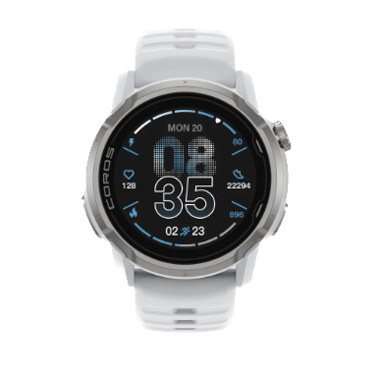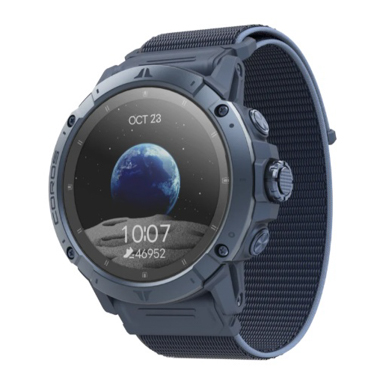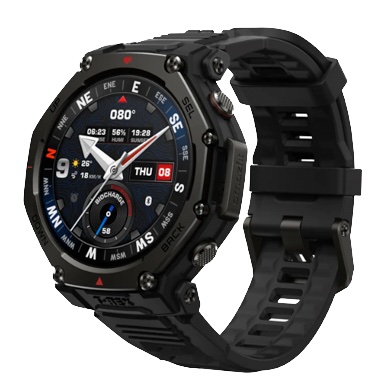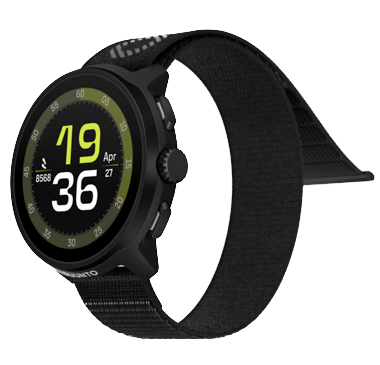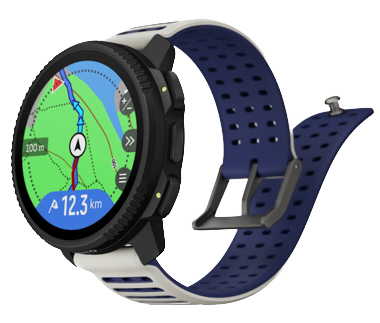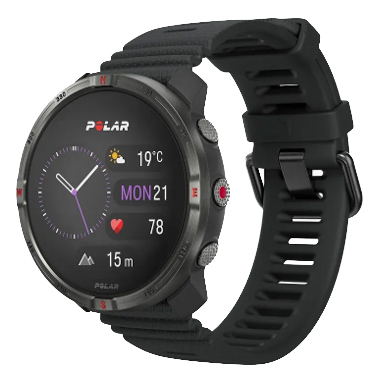
A GPS watch can track various metrics before, during, and after your run and help you maximize your workouts. Photo: iRunFar/Eszter Horanyi
If you’re looking into options for the best GPS running watch and feeling overwhelmed by the options and their price tags, you’re not alone. As runners, many of us are deeply committed to the sport, and some of us have a thirst for our personal data rivaling the overlords at Meta. Then, others of us want a simple watch to keep track of time and maybe measure our heart rate. And then some runners choose to go with no technology at all. Regardless of where you fall on the spectrum, our testing of various GPS watches on the market will help you choose the best one for your needs and budget.
When testing watches, our team looked at battery life, screen size, features, and durability. This guide builds on years of testing, comparing the latest watches to their predecessors and identifying what stands out. Our team of runners of all types analyzed which watches worked best for different situations, runner needs, and budgets. We continually update this guide as new models of watches hit the market.
The Garmin Forerunner 570 is our favorite for its features, appearance, and price. If you’re looking for lower-priced options, we recommend the Suunto Run or the Amazfit T-Rex 3 Pro, as they provide a lot of features at a very reasonable price..
To learn more about the lingo associated with GPS watches, how we came up with our list of favorites, and things to consider when choosing yours, look at the how-to-choose section, frequently asked questions, and research and testing methodology below our picks.
Best GPS Running Watches
- Best Overall GPS Running Watch: Garmin Forerunner 570
- Best Smartwatch for Running: Apple Watch Ultra 3
- Best GPS Running Watch Update: Coros Apex 4
- Best Battery Life in a GPS Running Watch: Coros Vertix 2S
- Best Value GPS Running Watch: Amazfit T-Rex 3 Pro
- Best Beginner GPS Running Watch: Suunto Run
- Best GPS Running Watch Design: Suunto Vertical 2
- Best Challenger GPS Watch: Polar Grit X2
Best Overall GPS Running Watch: Garmin Forerunner 570 ($550)
Pros:
- Best runner-centric feature set
- Light and easy to wear
- Fast processing with exclusive features
Cons:
- Not durable enough for mountain sports
- Prone to annoying crashes
While Garmin has an array of watches ranging from those with every feature imaginable to reasonably basic, the Garmin Forerunner 570 is the most complete mid-premium device designed for runners that the brand has released.
Five years ago, when I began testing GPS running watches in earnest, I was what you might call a “bigger is better” person — always reaching for the largest, most spec-heavy device available for trail running.
I leaned heavily on Garmin’s fēnix and Enduro lines, including the Garmin fēnix 7 Solar Edition and the Garmin fēnix 8 AMOLED. I still respect how capable those adventure watches are, but over time, my priorities shifted. I’ve come to appreciate smaller, more running-focused designs with cleaner interfaces, less gimmickry — think solar-powered glass — and far more reasonable price tags. A thousand-dollar adventure watch just isn’t what most runners actually need. But one thing hasn’t changed, though: I still think Garmin makes the best all-around GPS running watch.
Competing offerings from Coros, Suunto, and Amazfit are improving every year, but Garmin continues to dominate when it comes to accuracy, training depth, and ecosystem strength. The Forerunner 570 feels like the true sweet spot — bringing the precision and intelligence of Garmin’s fēnix and Epix lines to a lighter, more comfortable watch focused squarely on all runners.
The 570 is lightweight and easy to wear all day, and it has an upgraded AMOLED display that’s bright without being overdone. It’s readable in intense sun, under dense tree cover, and at night without glare or blown-out contrast. Garmin’s classic five-button interface is still a huge advantage, especially while wearing gloves or trying to operate the watch while running on uneven surfaces. Weighing 50 grams, it’s a watch you forget you’re wearing.
The 570 separates itself in GPS accuracy and trail performance. Garmin’s multi-band and multi-GNSS chipset now appears in this mid-tier model, offering the kind of precision you once had to buy a fēnix to get. Road pacing stays remarkably stable, even during surges or structured intervals. On the trail, the watch handles canyons, tree cover, switchbacks, and altitude shifts with impressive consistency. Satellite lock is near-instant, and track quality remains clean and believable even in environments that confuse cheaper sensors.
Battery life continues the “just right” approach. You get 18 hours in all-systems GNSS and multi-band GPS mode, and about 11 days of use in smartwatch mode — enough for marathons, 50k races, and long training weeks without constant charging.
Garmin’s training ecosystem remains unmatched, and the auto-climb feature stands out for trail runners, breaking climbs into segments so you can pace strategically. Navigation is another major strength, with offline maps, turn-by-turn routing, and seamless compatibility with Garmin Connect and Strava.
The 570 isn’t flawless. Before a September race, I loaded my PacePro plan only for the watch to freeze at the starting line and becoming useless until it auto-restarted twenty minutes later, costing me several recorded miles. And offline Spotify integration, one of my must-have Garmin features, still suffers occasional playback interruptions. These frustrations stand out because the rest of the watch works so seamlessly.
The Forerunner 570 balances elite accuracy, powerful training tools, excellent navigation, and comfort better than any other watch I’ve tested this year. It’s the most complete GPS running watch of 2025 — and the clear top pick.
Shop the Garmin Forerunner 570Best Smartwatch for Running: Apple Watch Ultra 3 ($800)
Pros:
- Seamless blending of life and running
- Health activity monitoring and advanced safety features
- Excellent for those interested in general fitness
Cons:
- Battery performance is weak compared to dedicated sports watches at this price point
- No Android compatibility
- Touch-first design is difficult to use with cold or wet fingers
At its core, the Apple Watch Ultra 3 remains a productivity smartwatch designed for endurance athletes who want rugged hardware, deep health tracking, and outstanding GPS performance. The new Ultra 3 isn’t a radical departure from the Apple Watch Ultra 2, but a few key upgrades improve its functionality.
Compared to the Ultra 2, this model offers longer battery life, a faster S10 processor, more storage, a larger and more efficient display, and, most excitedly for ultrarunners and backcountry athletes, emergency satellite connectivity. When off-grid, this watch can reach satellites to send messages, share your location, and communicate with emergency services — and it can do this all without your phone. While we haven’t had a chance to test this feature on this specific watch, we’ve been impressed with the reliability of the satellite communications of iPhones with similar technology. For trail runners, hikers, and anyone who ventures into remote terrain, this is a meaningful safety upgrade. The watch keeps the safety features of the previous version, like crash detection, fall detection, and an 86-decibel siren.
Battery life is a tangible improvement this year. Apple claims up to 42 hours of regular use, 72 hours in low-power mode, and up to 14 hours of continuous GPS tracking with heart rate monitoring. If you need a longer tracking time, you can put the watch in low power mode where it makes fewer GPS and heart rate readings, and the battery will last up to 35 hours. The watch’s charging is faster now too, and runners can expect an 80% charge in about 45 minutes.
For the display, a new OLED panel with a thinner bezel makes room for a slightly larger screen. The always-on mode now updates every second, which makes watch faces and data fields easier to read during a run. As before, brightness is excellent, and the touchscreen is quick and responsive — though still not ideal with wet hands or gloves.
Some familiar drawbacks remain with the Apple Watch Ultra 3. You still need an Apple device to activate it, mapping and routing still lag behind dedicated sports watches, you can’t natively upload a route to follow during a workout, and the compass workaround requires manual juggling between apps.
But as an all-in-one device, the Apple Watch Ultra 3 is outstanding. Running with only this watch and earbuds — with music, calls, messages, and safety features fully onboard — remains one of its biggest strengths. If you’re upgrading from a non-Ultra Apple Watch, the leap is a big one.
For Ultra 2 owners, the decision to upgrade comes down to how much you value the better battery, larger display, and satellite safety features. Overall, this is the most capable Ultra watch yet — a rugged and connected device that can handle daily training and save your bacon in the backcountry without carrying an auxiliary device like a Garmin InReach.
Shop the Apple Watch Ultra 3Best GPS Running Watch Update: Coros Apex 4 ($430)
Pros:
- Cool voice integration announces data
- Great value
- Frequent firmware updates regularly improve features
Cons:
- MIP display can be hard to read
- Currently, only available in stock black and white options
The Coros Apex 4 combines running-specific performance features with the ruggedness needed for mountain-sport athletes. In Coros’s athlete matrix, it’s not the Eliud Kipchoge or the Tommy Caldwell — it’s the Kilian Jornet: a blended runner, climber, and skier who goes long or short in a variety of environments. It showcases Coros’s most up-to-date technology — voice alerts, calls, voice pins, improved sensors, and more — wrapped in one distinctly low-tech choice by 2025 standards: a MIP display. In fact, it’s only one of two watches in this entire guide without an AMOLED display, and while that’s a matter of visual preference, the low-tech display’s impact on battery life is undeniably an advantage. The watch sits in the mid-tier price bracket and is competitive with its peers in some ways, and behind in others. That said, it’s also the strongest updates we’ve seen this year, bringing Coros’s newest features into a watch that’s far more usable for runners than the company’s newest outdoor flagship device, the Nomad.
Having fully crossed over into the AMOLED era, I was legitimately shocked by the MIP display. Nearly every watch I’ve tested in the past two years has arrived with a bright, phone-like AMOLED panel. I was so surprised by the Apex 4’s dimness that I texted iRunFar founder and Gear Editor Bryon Powell to confirm whether it was just me. Bryon, not an AMOLED acolyte, finds the display perfectly suitable. It’s worth noting that the Apex 4 has no brightness adjustment, though runners can toggle a white background for slight improvement.
The Apex 4 uses super-strong sapphire glass for exceptional durability and scratch-resistance, and is the same glass used on Coros’s highest-end mountain watches. Coros also adds the Action Button on the lower left side of the case that gives quick access to frequently used features — including your maps, saved pins, and any shortcuts you configure. For runners and mountain athletes who prefer tactile control over touchscreen swipes, the new button is a meaningful usability upgrade that makes mid-run navigation or note-taking dramatically more efficient. If maximizing battery is a priority, the Apex 4 is a better bet than Coros’s AMOLED models and offers 41 hours of GPS use.
Satellite lock is near-instant, cornering is accurate, and elevation data is stable. In road, foothill, and track testing, it performed on par with the Coros Pace Pro and significantly better than older Apex models. It’s not quite to the level of Suunto Vertical 2 in extreme terrain, but everywhere else, it’s excellent.
The Apex 4 debuts Coros’s most ambitious voice-tech package to date, and it’s genuinely useful. Voice alerts read out splits, laps, and heart rate zone changes clearly enough that you rarely need to look at the screen. You can answer calls via Bluetooth and dictate short voice pins mid-run, which sync to the app automatically. For trail runners who want to capture route notes, conditions, or nutrition reminders, voice pins are one of Coros’s best new features.
The Apex 4 also brings Coros’s best mapping experience yet. Scrolling is fluid, labels are clearer than on any previous Apex, and map detail has been meaningfully upgraded. While AMOLED watches will always look sharper, the MIP maps remain surprisingly readable and deliver far superior battery endurance during navigation-heavy outings.
The Apex 4 is Coros’s most complete iteration in this series. If you prioritize battery life, reliable GPS, excellent mapping, rugged durability, handy hardware controls, and surprisingly effective voice tech over a pretty screen, it’s one of the best performing watches of 2025.
Shop the Coros Apex 4Best Battery Life in a GPS Running Watch: Coros Vertix 2S ($700)
Pros:
- Great battery life
- Improved optical heart rate monitor sensor
Cons:
- No major upgrades
- Not great for casual wear
The Coros Vertix 2S is an upgrade on the previous watch in this category, the Coros Vertix 2. With improved GPS accuracy and the newest optical heart rate monitor, this watch’s updates are relatively minor. That said, we loved the last version, and this watch keeps everything we appreciated about its predecessor. We acknowledge that this probably isn’t a pure runner’s watch, but people who go on long adventures will use and appreciate the many features.
The new upgrades actually decrease the battery life of this watch. Still, it has 118 hours of battery in standard GPS mode — nine hours less than the previous model. Much of the decrease comes from the new optical heart rate monitor sensor. The watch uses an algorithm to account for your running cadence to edit out the extraneous noise that often affects wrist heart rate measurements.
We’ve always found this line of Coros watches to be the most accurate when navigating terrain without a clear view of the sky, like slot canyons in Utah. Compared to watches from other brands, its pings seemed to jump around far less.
The body of this watch features sapphire glass and a titanium bezel, making it extremely rugged. It makes it less-than-ideal for casual wear for most people, but you can trust it to stand up to the rigors of the mountains.
The 1.4-inch screen is larger than most others on the market and will dwarf smaller wrists, and some of our testers had a hard time fitting it through the wrist holes of shirts they were wearing. The large face does provide plenty of space to see up to eight data fields at once, and it makes navigation a little easier on the eyes.
If you don’t like to charge your watch often or want one to accompany you on long adventure runs, fastpacks, or other multi-day expeditions, the battery life and features of the Coros Vertix 2S can’t be beaten.
You can read more about the details of this watch in our in-depth Coros Vertix 2S review.
Shop the Coros Vertix 2sBest Value GPS Running Watch: Amazfit T-Rex 3 Pro ($400)
Pros:
- Incredible features for the price
- Most beautiful display of any watch in this guide
- Very fast processing power
Cons:
- Somewhat chintzy app and software
- A.I.-oriented data learning feels contrived
One of the bigger surprises in the GPS watch market this year has been the Amazfit T-Rex 3 Pro. The watch offers the capabilities of a Garmin fēnix at a far more accessible price. With competitive battery life, one of the most stunning displays on any watch I’ve tested, and deep biometric analytics, the brand makes a compelling case as the best value in performance wearables right now.
What immediately stands out is the 1.5-inch AMOLED display. It’s the brightest and most vivid screen we’ve tested, with contrast and sharpness that make traditional MIPS displays feel muted by comparison. If you’re coming from a Garmin fēnix, Coros Apex or Vertix, or any non-AMOLED device, one glance at the T-Rex 3 Pro is like a jolt of espresso — colors pop, maps are actually enjoyable to navigate, and data fields are legible at every angle.
Amazfit has spent the past few years quietly reinventing itself from a budget-friendly alternative into a legitimate challenger to the legacy GPS brands. The design is bold and armored, albeit a tad chintzy — kind of like a generic PC next to a cutting-edge looking Apple — but it’s much more refined than previous generations. Amazfit uses sapphire glass on this rugged trail model, and durability appears excellent so far. I haven’t crash-tested it with a full trail wipeout, but after several scrapes against granite and sandstone, the lens remains completely scratch-free.
Under open skies, accuracy is strong, pacing is stable, and satellite lock is quick. On dense, winding trails, the watch still performs well overall, though it doesn’t quite match Garmin’s top chipsets. Occasional micro-wobbles happen in tough conditions, but they’re rare. What stands out most is the responsiveness — pace changes register quickly without smoothing or lag, a feature that has historically held back value-tier watches.
Battery life remains one of Amazfit’s defining advantages, with up to 38 hours of dual-band GPS use. With dual-band GPS and always-on display active, the T-Rex 3 Pro still lasts multiple training days before needing a charge. With settings optimized, stretching it beyond a week is easy.
Amazfit’s health and training ecosystem — built on parent company Zepp’s operating system — continues to mature. Stress scores, sleep tracking, recovery metrics, and training load estimates are all here. Garmin still leads in coaching and long-term analytics, but the Zepp app presents data in a clean and intuitive manner, and the overall experience is smooth.
Navigation features include turn-by-turn guidance, offline maps, and reliable syncing with popular route platforms. Smartwatch features like notifications, weather, music control, and a growing Zepp OS app library round out the package and make the watch feel far more premium than its price.
The T-Rex 3 Pro represents the most polished version of Amazfit’s identity: bold, durable, extraordinarily bright, and packed with functionality. It doesn’t quite match Garmin’s ecosystem depth, but no other brand delivers this level of performance, ruggedness, and battery life for the price.
Shop the Amazfit T-Rex 3 ProBest Beginner GPS Running Watch: Suunto Run ($250)
Pros:
- Beautiful, lightweight form factor
- Vastly improved heart rate sensor
- Improved processing speed
Cons:
- Prone to ‘sticky’ buttons when lapping or accessing data pages
- Relatively weak battery life
Suunto has long been known for its rugged, mountain-ready — and sometimes comically bulky looking on normal or small wrists — multisport watches, and the Suunto Run takes a refreshing U-turn toward almost extreme minimalism. If you have used a Suunto in the past, taking the Run out of the box will have you double-checking your assumptions, and actually wearing the Run — with its super-comfortable, soft nylon strap — will reveal its key advantage. At only 36 grams with the textile ban, it is easily the lightest watch in this buyer’s guide, though the new Coros Pace 4 takes the lightest title this year at 32 grams. As for performance, it also ramps up processing power and has a decreased lag time while in an activity and scrolling through data pages.
The AMOLED display is brilliantly bright and very easy to read, with large digits and uncluttered data fields that make quick glances simple. The interface is intuitive, and menus are structured logically enough to learn the watch in minutes. It truly prioritizes activity — not bells and whistles — so much so that you can navigate to start a run in just one click.
Build quality is far better than expected at this price, with a sturdy polymer case, stainless steel bezel, Gorilla glass, and strong water and impact resistance.
GPS accuracy is one of the watch’s strongest attributes. Suunto’s heritage in navigation shows even in this entry-level model. The watch has a dual-band multi-GNSS chipset — awesome for a watch at this price point — allowing it to lock onto the best available satellites for optimal accuracy. Post-run syncing and processing speed are historically two of Suunto’s biggest pain points. Both are improved but still the slowest among the watches in this guide.
Compared to other watches in this guide, the Suunto Run’s battery life is just average. You can expect about 20 hours of GPS runtime in the highest-accuracy dual-band satellite mode with bio-monitoring and brightness features on high, and you’ll get upward of 40 hours with the power-saving GPS mode enabled.
Training features focus on essentials rather than advanced analytics. A reliable optical heart-rate sensor, basic recovery indicators, structured interval support, and suggested workouts give new runners everything they need to build fitness safely. Pace, distance, cadence, and effort metrics sync seamlessly to platforms like the Suunto app, Strava, and TrainingPeaks.
The Suunto Run nails exactly what beginners need: accuracy, durability, simplicity, and value. It feels intentionally designed to remove friction, reduce distractions, and give new runners a trustworthy, confidence-building tool. For anyone buying their first GPS device or returning to running with a desire for clarity and ease, this is the most compelling entry-level option.
Shop the Suunto RunBest GPS Running Watch Design: Suunto Vertical 2 ($600 – $700)
Pros:
- Exceptional battery life
- Most beautiful overall
- New adjustable flashlight is incredibly useful
Cons:
- Bulky, heavy, and not ideal for smaller wrists
- Expansive features may be too unfocused for pure runners
At around $600 (stainless steel) and $700 (titanium), the Suunto Vertical 2 brings the brand’s strongest hardware to date, with their latest chipsets, sensors, and processing power. GPS accuracy is exceptional, and the new heart-rate sensor finally produces readings that rival your old chest strap. There’s plenty of onboard storage for free worldwide maps — though downloading a state-sized region like Colorado still takes close to an hour over Wi-Fi. Battery life is outstanding, providing nearly 60 hours of continuous, full-accuracy GPS on a single charge, and over 200 hours in the deepest power-saving modes.
Design is where the Vertical 2 truly separates itself. Suunto continues to favor clean geometry, symmetry, and subtle material transitions. Suunto has unveiled a raft of new watches over the last few years, expanding their options to meet runners and outdoor athletes with new price points and features that better match a wide variety of needs. With all its new watches, Suunto has retained its Scandinavian design aesthetic, which, to me, still presents the most premium, cleanest, and aesthetically pleasing GPS watches on the market.
A major part of Suunto’s design aesthetic now centers around the AMOLED display. Suunto has rolled out the display across its entire running and outdoor line and has even said it likely won’t produce another MIP device again. That’s great news for fans of crystal-clear brightness and HD-quality mapping, though a concern if you prefer the softer, less power-hungry feel of MIP screens. Still, on a 1.5-inch display — the largest in this guide — AMOLED looks outstanding. And since the Vertical 2 no longer uses the solar energy-collecting glass found on the first Vertical, Suunto reclaimed even more space for visibility and mapping detail on the front panel.
Despite its substantial size, the Vertical 2 sits flatter and more naturally on the wrist than earlier Suunto giants thanks to tapered walls and angles. The thick silicone strap remains one of the best in the industry: soft, slightly stretchy, and secure. It’s comfortable enough to be positioned on the wrist where the heart rate sensor sits best. The three widely spaced metal buttons maintain Suunto’s minimalist ethos and provide a firm, glove-friendly click.
Suunto has added a feature that seems small but becomes indispensable once you use it: a very bright front-of-unit flashlight — as opposed to the backlight-based flashlight on the Suunto Race series. With multiple brightness settings, it’s remarkable for navigating camp or just making it to the bathroom in the middle of the night without your phone.
As you might expect, this is a watch that harkens back to Suunto’s past: a huge display, a thick, ultra-comfortable strap, and a bomb-proof bezel. But it pairs that classic ruggedness with modern components, one of the best displays in the category, and a level of industrial design that remains unique to Suunto.
Shop the Suunto Vertical 2 - stainless steelShop the Vertical 2 - titanium
Best Challenger GPS Watch: Polar Grit X2 ($800)
Pros:
- Nice design
- Relatively compact
- Unique features and quirky user interface
Cons:
- Quite expensive compared to other watches in its class
- No offline labeled maps
Coming from a brand that used to dominate fitness devices 15 years ago, the Polar Grit X2 is a return to the competitive end of the market for the company. Polar has existed as a fitness device brand for over 50 years, but seemed to lose its footing around the 2010s when you couldn’t line up to a running, cycling, or other endurance activity or race without seeing a Polar heart rate chest strap, cadence monitor, bike computer, or wrist watch attached to nearly every athlete in the field. Since then, Polar has been flat-out eclipsed by a core set of running watch brands that have been faster to react, market, and innovate for modern customers.
Despite getting overtaken by Coros, Garmin, Suunto, and even Apple, Polar has quietly produced some excellent devices over the past couple of years with competitive features and a software ecosystem that could be described as quirky — in a good way! The Grit X2 took a long time to make it to the United States market after becoming available in Europe early in the year. The scuttlebutt suggests that some tenuous trade agreements could be behind the delay, as well as the cost.
At $800 the Grit X2 is very expensive, though it is the “affordable” option behind its even more expensive sibling, the Grit X2 Pro, which comes in at $1,000. The X2 is a tad lighter, smaller, and slower compared to the Grit X2 Pro, but it has the same gorgeous AMOLED display and a highly adequate battery life of around 30 hours in its best performance mode. The Grit X2 — like the Suunto Vertical 2 and Coros Apex 4 — is a capable running watch that also plays well in other mountain sports settings.
The watch’s Scandinavian design is similar in some ways to Suunto’s balance of rugged but not bulky. It has a 1.28-inch display protected by sapphire glass, and it has proven to be extremely easy to read in bright sunlight and has withstood a couple big diggers. Despite all this toughness, it remains wearable for everyday use, and the tactile buttons are optimized for gloved hands, making it truly a watch that can handle city streets, mountain summits, and everything in between.
In short, the Polar Grit X2 is a well-rounded, highly capable watch that deserves more attention from outdoor athletes and runners alike. It proves that Polar can still compete with the biggest names in the industry. While it may not have dominated headlines like Garmin or Apple over the past decade, the Grit X2 quietly delivers on all fronts: accurate dual-band GPS chipset, advanced biosensing, robust navigation, and rugged durability.
Shop the Polar Grit X2Comparing the Best GPS Running Watches
| WATCH | PRICE | AVG. BATTERY LIFE (GPS mode) | DISPLAY SIZE |
| Garmin Forerunner 570 (47 mm) | $550 | 18 hours | 1.4-inch AMOLED |
| Apple Watch Ultra 3 | $800 | XXX hours | 1.9-inch Retina |
| Coros Apex 4 (42 mm) | $430 | 41 hours | 1.2-inch MIP |
| Coros Vertix 2S | $700 | 118 hours | 1.4-inch MIP |
| Amazfit T-Rex 3 Pro (48 mm) | $400 | 38 hours | 1.5-inch AMOLED |
| Suunto Run | $250 | 20 hours | 1.32-inch AMOLED |
| Suunto Vertical 2 (Titanium) | $700 | 65 hours | 1.5-inch AMOLED |
| Polar Grit X2 | $800 | 30 hours | 1.28-inch AMOLED |

The Coros Vertix 2S offers a wide range of features and great battery life but is too big for casual wear for many. Photo: iRunFar/Eszter Horanyi
Glossary of GPS Running Watch Terms
- Barometric Altimeter: A measurement of altitude that uses barometric pressure. It is used to determine elevation changes and can also measure changes to atmospheric pressure caused by weather patterns, allowing some GPS watches to issue helpful weather alerts.
- GPS: Global Positioning System is a United States military satellite system that allows a device to pinpoint its location on Earth. GPS, GLONASS, GALILEO, QZSS, and Beidou are the five main global positioning satellite systems. They’re sometimes more generically referred to as GNSS or global navigation satellite systems.
- Chipset: This is the relay between the processor and the storage in a GPS watch. The quality and modernity of the chipset will affect the watch’s processing speed and the ability to navigate between screens and select functions. GPS watches have an independent navigation chipset that plots one’s location.
- Bezel: A watch bezel holds the face covering of the watch in place. In GPS watches, the materials are typically very strong and durable.
- Water resistance: The watch’s ability to keep water out of the internal electronics. All GPS running watches are typically weatherproof and waterproof up to 100 meters deep.
How to Choose the Best GPS Running Watch
Accuracy
What we fundamentally want from the best GPS watch for running is to correctly measure a run’s distance, pace, and elevation change. Thanks to incredible innovation in satellite technology and specific algorithms designed for sports by watch manufacturers, we now have incredibly complex technology in a package small enough for your wrist. Even relatively inexpensive watches like the Suunto Run have exceptional GPS accuracy.
When it comes to accuracy, we’re often perplexed when, after trail running with a friend, we compare distance and vertical gain and see different results. This is sometimes a function of different brands’ technology, but it is often a function of battery power-saving modes, the number of GPS readings per minute you’ve selected, or the default settings on your watch.
Utilizing the maximum location measurement frequency will sap a watch battery, but while spacing out the readings is easier on the battery, it creates a less precise track. Obstructions in the sky, like trees or even clouds, can affect GPS accuracy, and the industry suggests GPS accuracy is within 1% to 3%.
Manufacturers recommend importing your data to a run-specific app, like Garmin Connect or the Suunto App, to corroborate your data with more sophisticated elevation models. We found that the most accurate GPS watch we tested was the Coros Vertix 2S, especially in areas where we didn’t have a clear view of the sky.
Battery Life
Battery life is arguably the most prized feature for ultrarunners looking for the best GPS watch. Fortunately, we are in something of a battery life golden age. Every major GPS watch company seeks to one-up their competitor to own the title of longest-lasting battery. This competition benefits the customer, as we’re not only getting batteries that can last up to 118 hours of normal GPS use, as with the Coros Vertix 2S, but they also charge incredibly fast.
When just a few years ago, companies would boast about 15 to 20 hours of battery life, and their watches might take three to five hours to charge from dead, we’re getting massive increases in battery life and equally as big drops in charging time. The Suunto Vertical 2 can go from dead to fully charged in under an hour and will then measure over 60 hours of activity.
Companies’ claims about battery life represent use with standard GPS tracking alone, without the additional battery demands of using navigation, receiving notifications, or playing music. Rather than manually tuning your watch to the best or worst battery performance, many manufacturers have preset battery modes that allow you to select the performance level you require based on your activity or the remaining battery power on the watch.
Comfort
Years ago, GPS watches looked like tiny computers on your wrist, and some, like the Suunto Vertical 2, are continuing to lean into the rugged and large aesthetic. As time passes, GPS watch sizes are getting more compact, and breakthroughs in technical performance are shrinking the package while adding new features.
Many brands offer different strap styles in addition to the normal silicone one, including nylon and other soft-style straps with elastic and hook-and-loop closures. These styles can add comfort and a more precise fit. The best example of this is the band included with the Suunto Run — it’s so light and comfortable you might forget you’re wearing it. All the watches in this guide are comfortable enough to wear all day, but the appropriateness of wearing a GPS watch to work or other life commitments varies depending on the user.
Watches like the Suunto Run or the Polar Grit X2 are small and stylish enough to wear in everyday life, while many people would shy away from wearing the Suunto Vertical 2 or similar rugged-looking watches in casual settings.
Ease of Use
The incredible technology in the best GPS running watches means there can be a learning curve to taking advantage of their full functionality. Not a single watch here is simple enough to pull out of the box and use all of the features immediately. You might be able to record a run — but what next?
Do you use the watch’s corresponding app to synchronize it? Do you make adjustments in the watch itself or with the app? Is it a combination of both? These are questions you’ll need to sort out as you begin accessing features on your watch and learning its capabilities. The Suunto Run is one of the simplest watches to learn to use.
With so many options and the amount of data provided, it even takes time to remember which buttons control selections and navigate forward or back. Some watches have a bold start/stop button distinct from the others. The watches in this guide use buttons, scrolling dials, touchscreens, or a combination of all three to operate.
Buttons are simple to use on the fly, but dials, like on the Coros Apex 4, can be tricky to use quickly. Buttons are generally big and responsive, with some performing much better than others. The watches in this guide with touchscreens generally work well even in wet or cold conditions.
Extra Features and App Compatibility
Each watch in this guide has a corresponding mobile app that can do everything from downloading your runs and sharing with a third-party app like Strava to designing and synchronizing routes. The apps can also control the colors and display of the watch face and synchronize firmware. Many watches have a coaching component that allows you to customize your workout or download workouts directly from professional athletes.
The Polar Grit X2 has a suite of features, including hydration tracking and menstrual cycle tracking. Several watches in this guide can sync offline playlists from streaming services like Spotify, or have built-in storage for music playback. Some watches, including the Apple Watch Ultra 3 and the Garmin Forerunner 570, have Mobile Pay.

iRunFar’s Meghan Hicks tests the Coros Vertix 2 in the slot canyons of Utah. We found it to provide more accurate GPS tracking than other watches in areas like slot canyons. Photo: iRunFar/Eszter Horanyi
Why You Should Trust Us
We at iRunFar are GPS running watch aficionados with a long history of testing watches. Many of our team members love pouring over running data, and we use our watches to collect accurate metrics of our runs and health. For the initial version of this guide, we combined our more than 100 years of GPS running watch field testing with polls of the iRunFar community to see what everyone thought was the best GPS running watch on the market. We selected nearly a dozen highly vetted watches for rigorous summer, fall, winter, and spring testing.
We tested these watches in climates from the densely forested northwestern United States to the cold, dry, and variable seasons of the Rocky Mountains in Colorado. We took different GPS watches out in difficult terrain, like slot canyons in Utah and mountains in Bhutan, to see if there was a difference in accuracy in places where they didn’t get a clear view of the sky.
We evaluated the watches based on their features, price, comfort, processing speed, accuracy, navigation capabilities, battery life, and compatibility with third-party apps. We continue to test new watches and update this guide when needed.
Frequently Asked Questions About GPS Running Watches
What is a GPS watch, and why is it helpful in trail running and ultrarunning?
Besides shorts and shoes, many runners consider a GPS watch a fundamental piece of running gear. It lets you easily and accurately record your runs and see important data. like pace and elevation gain, while you’re out there. The data synchronizes with popular apps, allowing you to compare or log your information securely. It’s a training log that doesn’t take up physical space.
Moreover, the watches in this guide work for more than just running. They track tons of other sports, such as paddleboarding, yoga, and cycling, and collect the unique metrics associated with each activity. Every watch in this guide can significantly improve your understanding of your body and training. The Garmin Forerunner 570 combines a lot of useful features for a reasonably competitive price.
This is not to suggest that trail or ultrarunning requires a GPS watch. For many, the invasion of more and more data in our lives is becoming burdensome and tiring. A pen-and-paper training journal combined with a simple stopwatch or using your smartphone with any number of free run-recording apps is much more inexpensive and simple.
Which running watch has the best GPS?
Each watch tested in this guide does a fine job of tracking your run. Positioning in these watches is usually acquired through one or a combination of the five major satellite systems (GPS, GLONASS, Galileo, QZSS, and Beidou). Different satellite systems have variable accuracy in different areas of the world. Incremental differences appear between all of the watches, even on the same activity, yet none of the watches tested here has an outlying poor output.
The Coros Vertix 2S has a feature that seeks to combat satellite interference, whether it’s from a dense forest or a deep canyon, by utilizing all five satellite systems at once. Choosing the best GPS watch could almost be more a matter of what else it has beyond good GPS accuracy, since there isn’t a poor performer among the bunch in this guide.

Apple watches can provide the same tracking and health metrics of top GPS watches. Photo: iRunFar/Eszter Horanyi
I want to race my first ultramarathon. Which GPS running watch should I use?
Many people will simply use their phone and the app like Strava for their first ultra. This is a low-cost and simple way to use a piece of hardware you already own and are probably going to carry regardless. The drawback is that your phone has a battery that probably won’t last beyond 50k.
If you’re new to ultrarunning and simply looking for the best GPS running watch for reliability and affordability, the Suunto Run and Garmin Forerunner 570 are excellent and affordable options. You won’t get all the fancy features of the highest-end watches, but you’ll get enough battery to last nearly any ultra.
The Amazfit T-Rex 3 Pro also packs in a lot of features at a reasonable price point. For ultrarunners who want to get the most technology, data, and performance out of their races and training, this guide has some truly exceptional options, namely the Suunto Vertical 2 and Coros Vertix 2S.
What’s the difference between a fitness tracker and a running watch?
This is a question mainly regarding features. Fitness trackers have come a long way and are more affordable than any watches tested in this guide. But their downside is that they rely heavily on pairing with a phone to draw out similar features that are built directly into GPS watches. The health and sleep monitoring features of the Amazfit T-Rex 3 Pro and the Polar Grit X2 can give you much of the information that dedicated fitness trackers provide.

From intervals to health metrics, GPS watches can measure and track all of your data. Photo: iRunFar/Eszter Horanyi
Which is the most accurate GPS watch?
When comparing all of the watches tested here on the same 25-kilometer run, not a single one had exact fidelity when comparing the GPX track to the trail marked on Mapbox, the commercial map provider for everything from Strava to the navigation system in your car. In some cases, the track showed a tester crossing an alpine lake, which they didn’t, or taking a very long detour around part of a forest.
You might expect the same brand of watches to provide the same output, but that wasn’t the case. There were deviations between watches across the board. We found that the advanced GPS system of the Coros Vertix 2S outperformed other watches when it came to difficult conditions, such as in slot canyons or under heavy tree cover.
Two of our testers who run together frequently find that a Coros watch consistently measures more distance when compared to a Garmin, but the Garmin reports more elevation gain. The consistency of the variability points toward differences in the algorithms used by the watches to calculate these numbers.
The industry says that most GPS watches are accurate within 1% to 3%, which explains the deviation in watches, even when tested simultaneously. A few watches have special features to improve their accuracy. Suunto employs its “Snap to Route,” where you could take a GPX file, load it into the watch, and then navigate that course while you run. This is a clever way to ensure that your run is as faithful to the intended route as possible, and it minimizes error due to satellite reception and other variables, like clouds, buildings, or other obstructions.
We asked the Garmin product manager to explain the differences between measurements of different watches on the same course. They said, “There are numerous challenges in forming an elevation profile over a long trail run or ultramarathon, like effects of weather over longer periods and how the watch is worn (for example, if the barometer port is up against clothing).”
They continued, “Because of these sources of error, we expect differences in the total ascent between runners, and these can add up over long-distance runs. On the distance side, GPS accuracy is the biggest thing. User settings, type of device, which arm the user is wearing the watch, running form, and environment (tree cover can affect the line of sight to satellites) can all affect accuracy.”

The Garmin Forerunner 165 Music is a great entry-level GPS watch that is simple to navigate and use. Photo: iRunFar/Eszter Horanyi
These watches are so expensive! What is the best budget running watch?
You’ll have to spend some money to get a reasonable GPS watch, though there are major variations in the price points among the different options. Chiefly, the ever-mind-blowing strength of their batteries that dictate the cost, plus a suite of other features that help you understand your physiology, including heart rate and blood oxygen saturation. A GPS watch can replace your phone as a podcast or music device, and they are incredibly durable with their titanium, steel, and sapphire materials. The Amazfit T-Rex 3 Pro offers many of the features of a high-end watch at a much lower price.
What’s the best running watch for small wrists?
Many GPS watches, like the Coros Vertix 2S, have big displays that look massive on even average-sized wrists. The large size makes it easier to see a lot of data and to navigate with offline maps. The Suunto Run, with a much sleeker design, won’t swallow smaller wrists. These two are at opposite ends of the price spectrum, separated by about $400. In the end, the best GPS running watch for you will be one that you’re comfortable wearing, so it’s worth considering fit when choosing one.

Both road and trail runners can benefit from the data collected by a GPS watch. Photo: iRunFar/Eszter Horanyi
What GPS running watch best integrates with smart technology so that I can stay connected while running?
All the watches in this guide — including the least expensive Suunto Run — display notifications from incoming calls, text messages, and emails on their screens. You must connect the watch to your smartphone via Bluetooth for this to work. The Apple Watch Ultra 3 is essentially a phone on your wrist.
I am bad with technology. What running watch is the easiest to use?
If ultrarunning is your primary sport, many of these GPS watches are overbuilt for what you actually need in terms of features. The Garmin Forerunner 570 is one of the more pared-down of these options, but it still has all of the features a runner needs.
The Apple Watch Ultra 3 is also an excellent option for those who struggle with technology. Like most Apple products, it provides a great user experience, and the dedicated action button makes it easy to put it on your wrist and go. It will still interpret your daily data, including sleep, and can guide you in improving your fitness and health.
Call for Comments
- What is your favorite GPS watch? Do you tend to replace them as technology advances?
- What is the most important element in a GPS watch, and are there some elements you never use?



